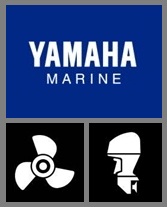
Yamaha showcased its new 250hp four-stroke engine to a group of marine media in September. The engine rounds out a full range of four-strokes from 2.5-250hp, including the recently-released and extraordinarily fuel-efficient 50, 60, 80, and 100hp four-strokes designed for small to medium-sized trailerboats. The four-stroke range compliments Yamaha's ever-popular two-stroke range, which is renowned for reliability and ease of servicing, and also includes the high-pressure direct-injection V-Max series from 150-300hp.
Of interest to small-boat owners is a new tiller handle, which is available for small- to mid-sized trailerboats. The tiller arm allows the operator to set trolling speed using a simple dial, anywhere from 600-1000rpm, and comes with electric start, throttle tension, power trim and tilt and gearshift functions at your fingertips. Combined with the extra length and ergonomic design, the new tiller arm makes controlling larger outboards easier than ever before. And it can be retrofitted to recent-model Yamaha outboards for just a few hundred dollars.
TOP GUN
The big news on the day, however, was the big 250hp four-stroke. The F250A houses a 3.3lt V6 powerhead with 24 valve DOHC technology delivering 250hp at the propshaft. The engine is based on the same 3.3lt powerhead from the F225A but boasts new single-belt driven Variable Camshaft Timing and 24 valve DOHC engine technologies to produce more low- to mid-range torque, outstanding fuel efficiency and exceptionally low exhaust emission levels, Yamaha claims.
Mounted on three different boats, the effect of the variable valve timing on the F250 could be felt immediately, with immense torque and pick-up being generated in the upper end of the rev range between 4000-6000rpm. Variable Camshaft Timing both increases and decreases the camshaft timing according to the engine rpm to increase the intake and exhaust efficiency throughout the low to mid range rpm band.
RELIABLITY
For additional strength and durability, the F250A features lightweight forged pistons and a heat-treated crankshaft and connecting rods. Yamaha opted for a single-belt drive with less moving parts, multi-point fuel injection for optimum all-weather operation and a high-output 46amp alternator to power all your boat's electrical systems.
Clean and fuel efficient operation is achieved through a blow-by gas re-burning system which removes any unburned fuel and sends it back to the combustion chamber. Quiet operation is also delivered by the large intake silencer and the noise-suppressing labyrinth exhaust system. Such refined engineering reduces exhaust emissions to CARB three-star levels. At all speeds, normal conversation could be had at the helm on all the boats - it really is a very smooth, quiet engine.
COMPUTER-CONTROLLEDYamaha's sophisticated Electronic Control Module (ECM) is the driving intelligence behind the F250A. The electronically-controlled single throttle valve system - a first for Yamaha - enables precise control over the air intake, which is directed smoothly into each combustion chamber for greater power. The ECM receives input from nine sensors located around the engine and warns the operator of any impending problems. Should any sensors fail, Yamaha's Fail Safe System keeps the engine running. Concerns of engine temperature, amp output, and oil pressure should now be non existent, Yamaha says.
To make maintenance easier, a front-mounted freshwater flushing port offers convenient engine flushing without turning the key. Reliability and longevity is also enhanced with Yamaha's five-stage multiple coating over YDC-30 aluminium, more stainless steel componets, zinc sacrificial anodes, a super-tight cowling and the flushing system help to protect against corrosion.
PERFORMANCE
An engine each was mounted on a 7.4m plate aluminium AMM fishing boat, Cruise Craft's 685 Outsider and a Whittley 700 Sea Legend. The 250 had loads of power, particularly in the bottom and top end of the rpm range. It was also remarkably quiet for such a large engine.
The F250 pushed the big Cruise Craft out to 80kmh at 5900rpm, using 80lt/h of fuel. Backed off, a sea-keeping cruise of 42kmh was achieved at 3500 using just 26lt/h of fuel - excellent efficiency for blue-water long-hauling and of high importance considering rising petrol prices.

No comments:
Post a Comment